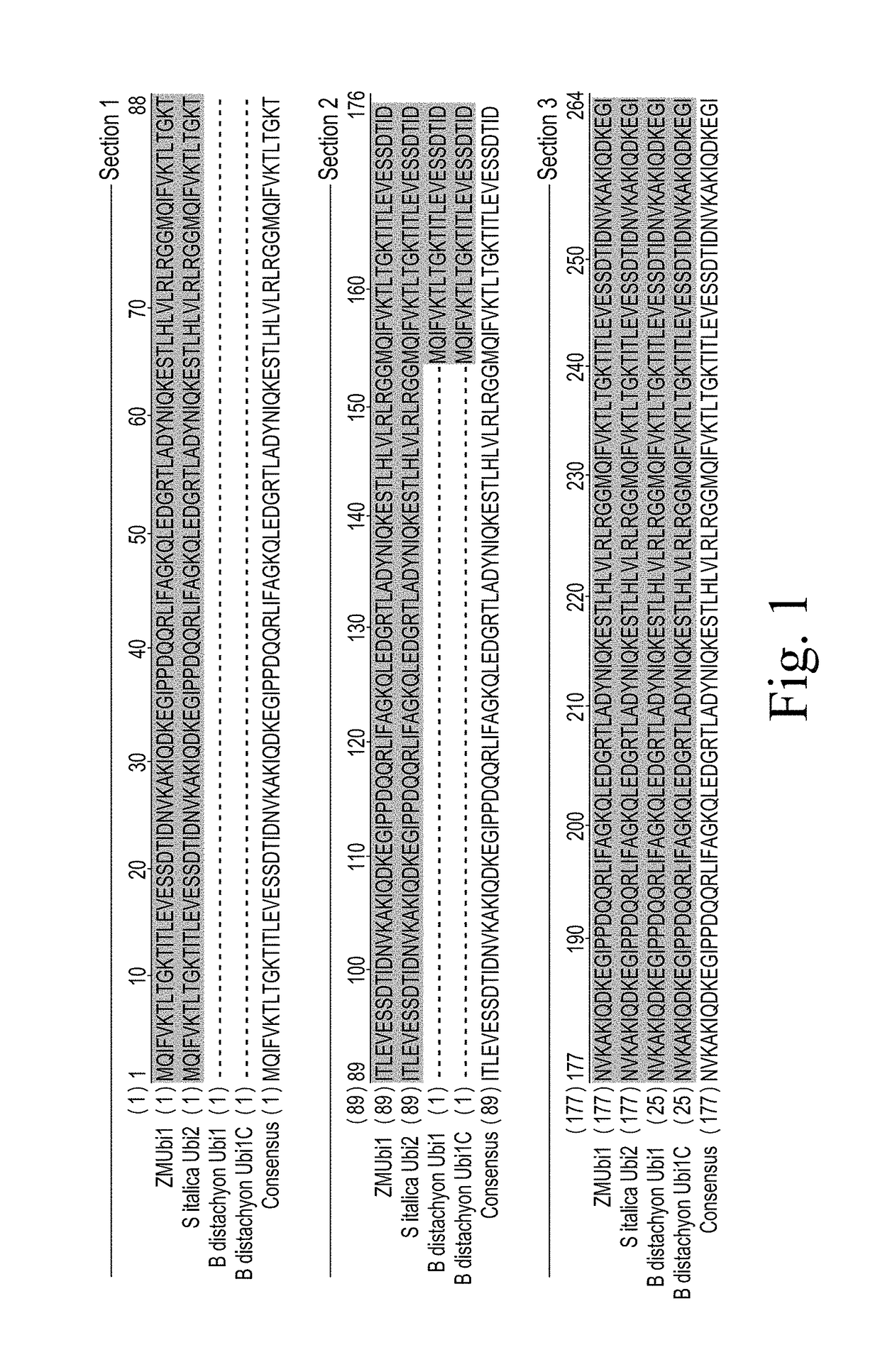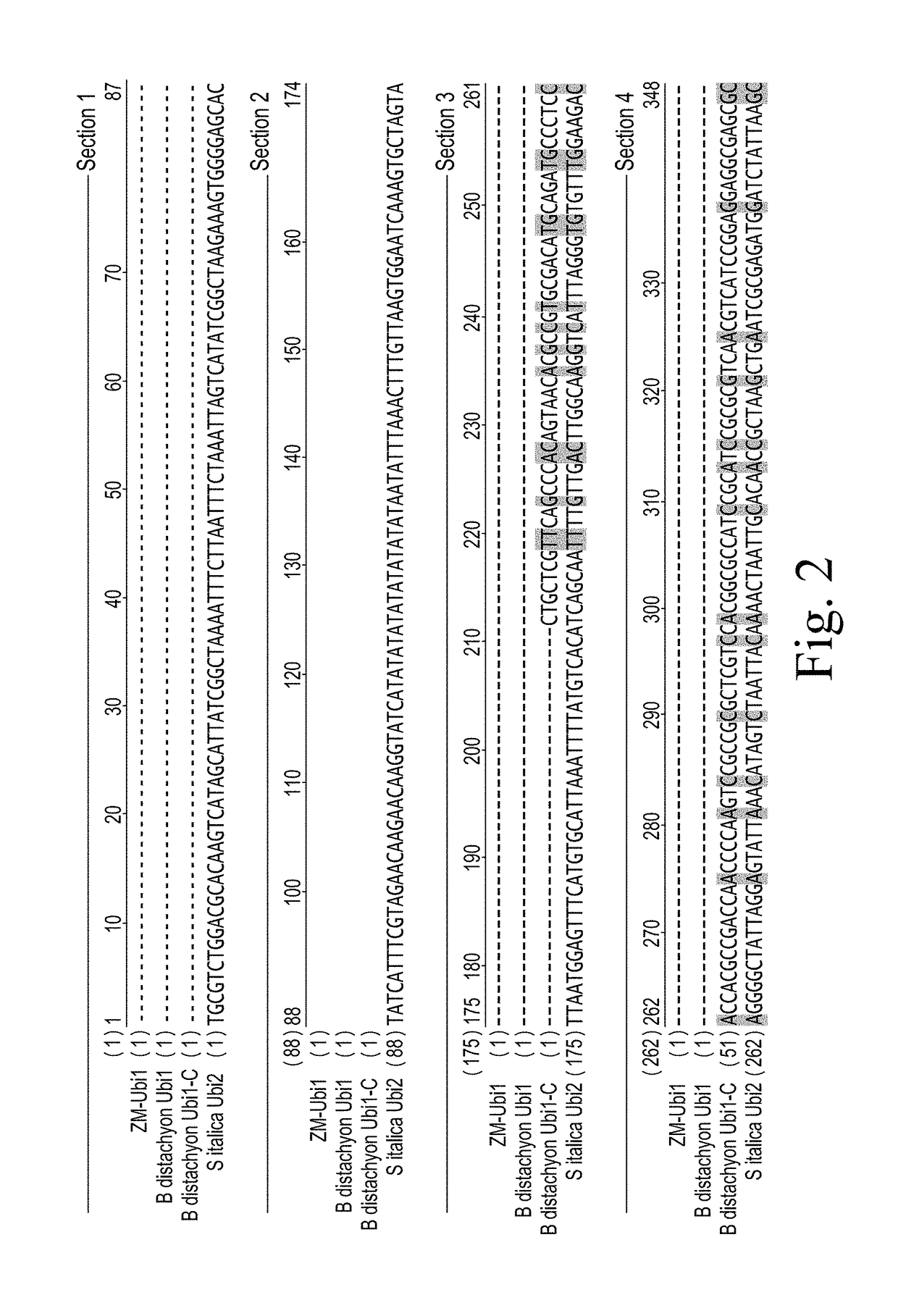Constructs for expressing transgenes using regulatory elements from brachypodium ubiquitin genes
- Summary
- Abstract
- Description
- Claims
- Application Information
AI Technical Summary
Benefits of technology
Problems solved by technology
Method used
Image
Examples
embodiments
[0105]As disclosed herein novel recombinant constructs are provided for expressing a non-ubiquitin transgene using the regulatory sequences of a ubiquitin gene from Panicum virgatum, Brachypodium distachyon, or Setaria italica. These constructs can be used to transform cells, including plant cells, to produce complete organisms that express the transgene gene product in their cells.
Regulatory Elements
[0106]Plant promoters used for basic research or biotechnological application are generally unidirectional, directing only one gene that has been fused at its 3′ end (downstream). It is often necessary to introduce multiple genes into plants for metabolic engineering and trait stacking and therefore, multiple promoters are typically required in transgenic crops to drive the expression of multiple genes.
[0107]Development of transgenic products is becoming increasingly complex, which requires stacking multiple transgenes into a single locus. Traditionally, each transgene usually requires ...
example 1
Transformation of Agrobacterium tumefaciens
[0219]The binary expression vectors were transformed into Agrobacterium tumefaciens strain DAt13192 (RecA minus ternary strain) (Int'l. Pat. Pub. No. WO2012016222). Bacterial colonies were isolated, and binary plasmid DNA was isolated and confirmed via restriction enzyme digestion.
Corn Transformation
[0220]Agrobacterium Culture Initiation.
[0221]Agrobacterium cultures were streaked from glycerol stocks onto Agrobacterium (AB) minimal medium (as disclosed in WO 2013090734, the disclosure of which is incorporated herein by reference) and incubated at 20° C. in the dark for 3 days. Agrobacterium cultures were then streaked onto a plate of YEP (see WO 2013090734) medium and incubated at 20° C. in the dark for 1 day.
[0222]On the day of the experiment, a mixture of inoculation medium (see WO 2013090734) and acetosyringone were prepared in a volume appropriate to the number of bacterial strains comprising plant transformation constructs in the expe...
example 2
Identification of the Promoters
[0236]The maize ubiquitin coding sequence was BLASTx searched in the Phytozome (Goodstein et al., 2012) database using Brachypodium distachyon and Setaria italica as target genomes.
[0237]
Maize Ubiquitin (ZM Ubi1) Coding Sequence(SEQ ID NO: 18)ATGCAGATCTTTGTGAAAACCCTGACTGGCAAGACTATCACCCTCGAGGTGGAGTCGTCTGACACCATTGACAACGTTAAGGCCAAGATCCAGGACAAGGAGGGCATCCCCCCAGACCAGCAGCGGCTCATCTTTGCTGGCAAACAGCTTGAGGACGGGCGCACGCTTGCTGACTACAACATCCAGAAGGAGAGCACCCTCCACCTTGTGCTCCGTCTCAGGGGAGGCATGCAGATCTTTGTGAAAACCCTGACCGGCAAGACTATCACCCTCGAGGTGGAGTCCTCTGACACCATTGACAACGTCAAGGCCAAGATCCAGGACAAGGAGGGCATCCCTCCAGACCAGCAGCGGCTCATCTTTGCTGGGAAGCAGCTTGAGGACGGGCGCACGCTTGCCGACTACAACATCCAGAAGGAGAGCACCCTCCACTTGGTGCTGCGCCTCAGGGGAGGCATGCAGATCTTCGTGAAGACCCTGACCGGCAAGACTATCACCCTCGAGGTGGAGTCTTCAGACACCATCGACAACGTCAAGGCCAAGATCCAGGACAAGGAGGGCATTCCCCCAGACCAGCAGCGGCTCATCTTTGCTGGAAAGCAGCTTGAGGACGGGCGCACGCTTGCCGACTACAACATCCAGAAGGAGAGCACCCTCCACTTGGTGCTGCGCCTCAGGGGAGGCATGCAGATCTTCGTGAAGACCCTGACCGGCAAGACTATC...
PUM
| Property | Measurement | Unit |
|---|---|---|
| Fraction | aaaaa | aaaaa |
| Digital information | aaaaa | aaaaa |
| Length | aaaaa | aaaaa |
Abstract
Description
Claims
Application Information
 Login to View More
Login to View More - R&D
- Intellectual Property
- Life Sciences
- Materials
- Tech Scout
- Unparalleled Data Quality
- Higher Quality Content
- 60% Fewer Hallucinations
Browse by: Latest US Patents, China's latest patents, Technical Efficacy Thesaurus, Application Domain, Technology Topic, Popular Technical Reports.
© 2025 PatSnap. All rights reserved.Legal|Privacy policy|Modern Slavery Act Transparency Statement|Sitemap|About US| Contact US: help@patsnap.com



